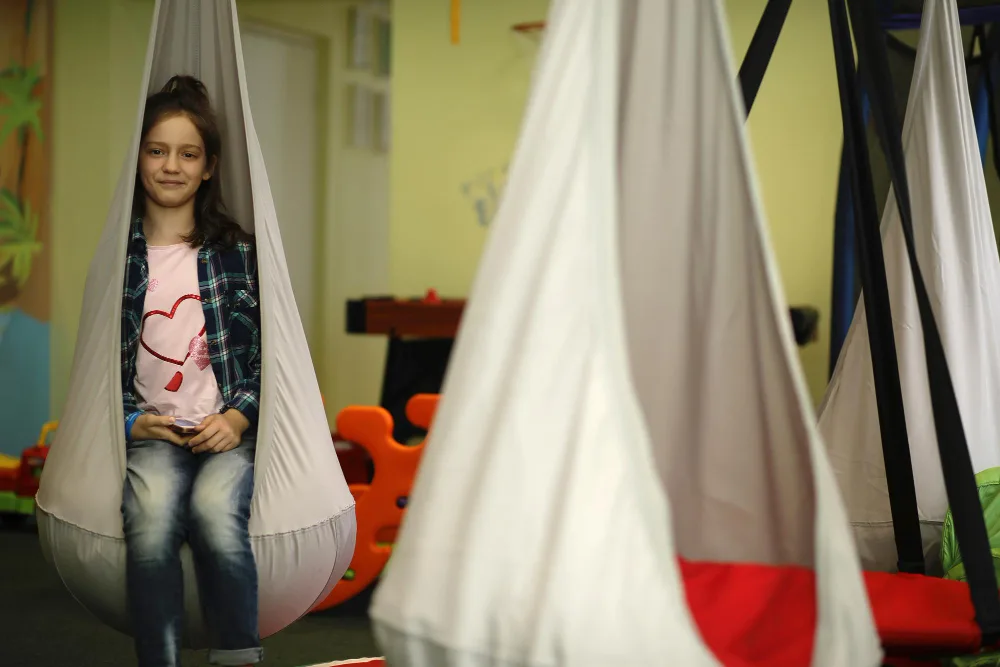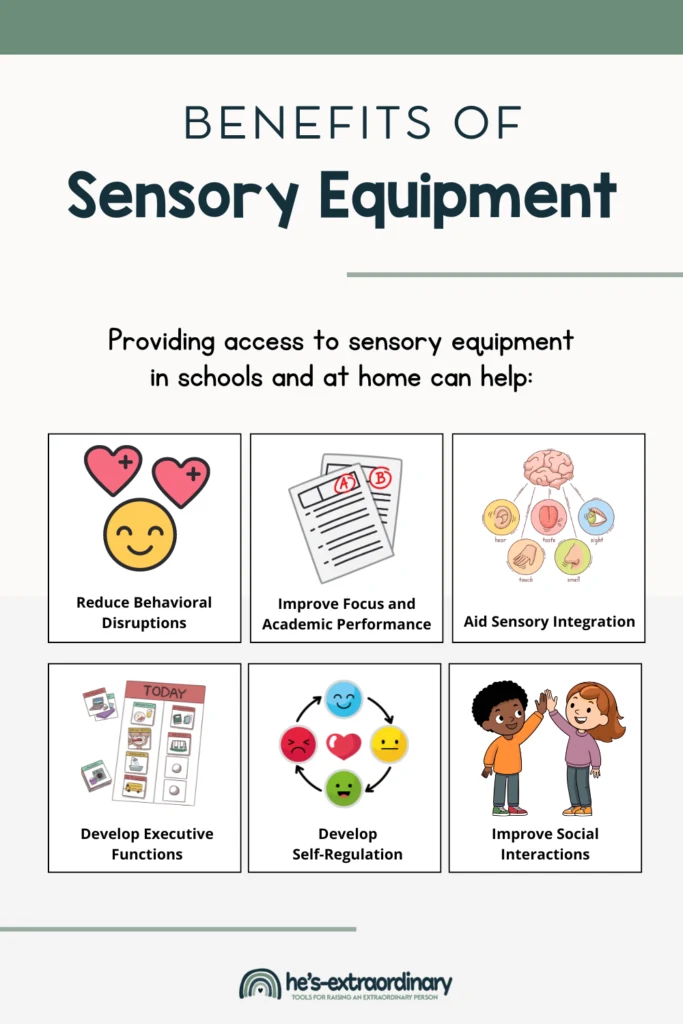What’s inside this article: Clear steps for parents and educators on how to access funding for sensory room equipment. Including what type of documentation you’ll need and what funding options are available.
**Includes free downloadable resources to aid families and educators.**
Disclaimer: This post contains affiliate links.

Sensory integration is a normal process in which the brain and nervous system receive information from all the senses and interpret it to create appropriate motor and behavioral responses.
Sensory Processing Disorder (SPD) is a condition that occurs when the brain has trouble receiving and responding to information from our senses. When this occurs, sensory signals are not organized and processed into appropriate motor behavioral responses.
SPD affects approximately 1 in 6 children. It can be a stand-alone condition, or it might be present with other conditions, like autism, ADHD, or learning disabilities.
Access to sensory equipment plays a vital role in helping children who have physical or developmental needs, like those with autism, ADHD, or SPD. However, the cost of high-quality sensory equipment often creates a financial barrier for parents and educators.
The Importance of Sensory Equipment
Sensory equipment is equipment specifically designed to aid sensory integration by providing targeted sensory experiences.
For example, sensory swings provide vestibular and proprioceptive input, which help with balance and spatial orientation. Plus, the rhythmic movement of a swing can calm an overstimulated child or stimulate an under-responsive one.
Why is it Important?
Sensory equipment is crucial for kids needing additional support with sensory integration.
Providing access to sensory equipment in schools and at home can help:
1. Improve Focus and Academic Performance:
Sensory equipment is designed to provide the right amount of stimulation needed to meet children’s sensory needs. Just like a rumbling stomach can make it hard to focus in class, unmet sensory needs have the same effect. Fulfilling sensory needs helps the brain stay engaged and attentive.
A study indicated that students who used sensory integration strategies showed a 25% improvement in task completion and a 15% increase in test scores.
2. Reduce Behavioral Disruptions:
Classrooms and schools equipped with sensory tools and equipment report fewer behavioral incidents. Sensory equipment helps mitigate both under and overstimulation, common causes of disruptive behavior among neurodiverse students.
Research indicates that sensory interventions can reduce classroom disruptions by up to 30%, creating a more conducive learning environment for all students.
3. Support Social-Emotional Development:
Self-regulation: Sensory equipment helps children develop self-regulation, the ability to manage emotions and behaviors in response to external demands, by teaching them to calm down and cope with sensory overload or under-stimulation.
Improves social interactions: Sensorily balanced children feel less anxious, which makes them more likely to engage in positive social interactions. Sensory equipment can also encourage cooperative play and help kids build peer relationships.
4. Positively Influence Cognitive and Sensory Development
Executive Functions: Sensory integration activities are linked to improvements in cognitive processing, aiding in the development of complex executive functioning skills like working memory, task initiation, problem-solving, and organization.
Sensory Integration: Regular access to sensory equipment helps students with sensory integration disorders better process the sensory information they perceive, which is crucial for academic performance and cognitive development.

Identifying Sensory Needs
Parents and educators can often identify unmet sensory needs just by observing children’s behavior.
How a child reacts to sensory experiences throughout the day can give you clues to their sensory needs.
Look for patterns in their behavior in response to:
- Auditory stimuli: Loud noises, crowded environments.
- Visual stimuli: Bright lights, busy patterns.
- Tactile stimuli: Different textures, touch by others.
- Vestibular stimuli: Movement, changes in head position.
- Proprioceptive stimuli: Body awareness through activities like jumping, pushing, or pulling.
- Olfactory and gustatory stimuli: Reactions to smells and tastes.
However, if you’re a parent, the approval process to access funding will likely include a professional recommendation from an occupational therapist (OT) or your child’s primary care provider.
- Initiating Consultation: Schedule an appointment with an OT or your child’s PCP to discuss their sensory needs. You can often access OT through their school, but private consultations are also an option. This may include an assessment, answering questionnaires, or observing your child engaging in various activities.
- Getting Professional Recommendations: After the assessment, request a written recommendation for sensory equipment that can support your child’s unique needs.
Sources of Funding for Sensory Equipment
Various financial resources, including federal and regional resources, are available for families, schools, and organizations.
Here are a few options, but it’s a good idea to search for regional resources specific to you.
For Families:
- Government Programs:
- Medicaid: This program can cover the costs of therapeutic sensory equipment under specific conditions. Eligibility and coverage vary by state, so consult your State’s Medicaid office for detailed information.
- State-specific Programs: Many states offer additional programs through their Department of Health and Human Services or equivalent agencies. These programs might include waivers or grants to support children with special needs.
- Insurance Coverage: Some private health insurance policies classify sensory equipment as durable medical equipment (DME). Review your policy closely and talk with your insurance provider about coverage options. Be prepared to submit medical justifications, including assessments from healthcare professionals.
- Grants:
- The Autism Society: Offers resources and sometimes funding for families needing assistance with sensory equipment.
- STAR Institute for Sensory Processing: Provides information and support for sensory processing disorder, including potential funding opportunities for equipment.
- The Variety Club: Variety’s Freedom Program helps fund equipment and services for mobility, independence, and social inclusion for individual children and children’s organizations.
- Local Non-Profits and Foundations: Many local organizations, such as the Easter Seals, support children with special needs and may offer grants or financial assistance for sensory equipment.
For Schools:
- Government Programs:
- Individuals with Disabilities Education Act (IDEA): Schools can receive funding under IDEA Part B and C to support children with disabilities. This funding can sometimes be used to purchase sensory equipment for educational settings. IDEA funding information can be found here.
- Grants:
- The McCarthey Dressman Education Foundation offers Academic Enrichment Grants designed to develop in-class and extra-curricular programs that improve student learning.
- Kaboom!: Kaboom! is a national organization that helps communities build accessible and equitable playgrounds.
- Action for Healthy Kids: Action for Healthy Kids provides grants to schools to help them accomplish their student wellness goals.
- The Variety Club: Variety’s Freedom Program helps fund equipment and services for mobility, independence, and social inclusion for individual children and children’s organizations.
- Community Fundraisers: Community fundraisers are a fantastic way for schools to gather the necessary funds for sensory equipment. Involving the students in fundraising can help them build compassion, empathy, and a sense of accomplishment. It can also help develop essential skills like planning, organization, teamwork, and problem-solving. Find some fun fundraising ideas here.
Getting the Most From Your Funding
Investing in sensory equipment is a game-changer for kids with autism and sensory needs. However, it’s important to make informed decisions to ensure that the funds are used effectively and have a lasting impact.
Book a free consultation with SensoryRX to receive expert advice and customized solutions for sensory needs. Their team can work with your budget and guide you through the selection of sensory equipment, ensuring that you invest in the right tools that will make a real difference in the sensory development and well-being of the children you’re supporting.
Booking a consultation with SensoryRX is your first step towards a happier and more emotionally regulated future for your children.
Free Downloads:
Don’t miss out on these essential resources — The “Waiver Checklist” guide simplifies the waiver process, offering a quick reference for families using Medicaid programs, disability assistance, federal grants, etc.
Additionally, our “Enhancing School Environments with Sensory Equipment” document/presentation is a powerful tool to enlighten budget controllers on the importance of sensory regulation, providing compelling evidence to support the need for sensory equipment.
Next up: 30 Sensory Room Ideas for Homes, Schools, and Clinics
